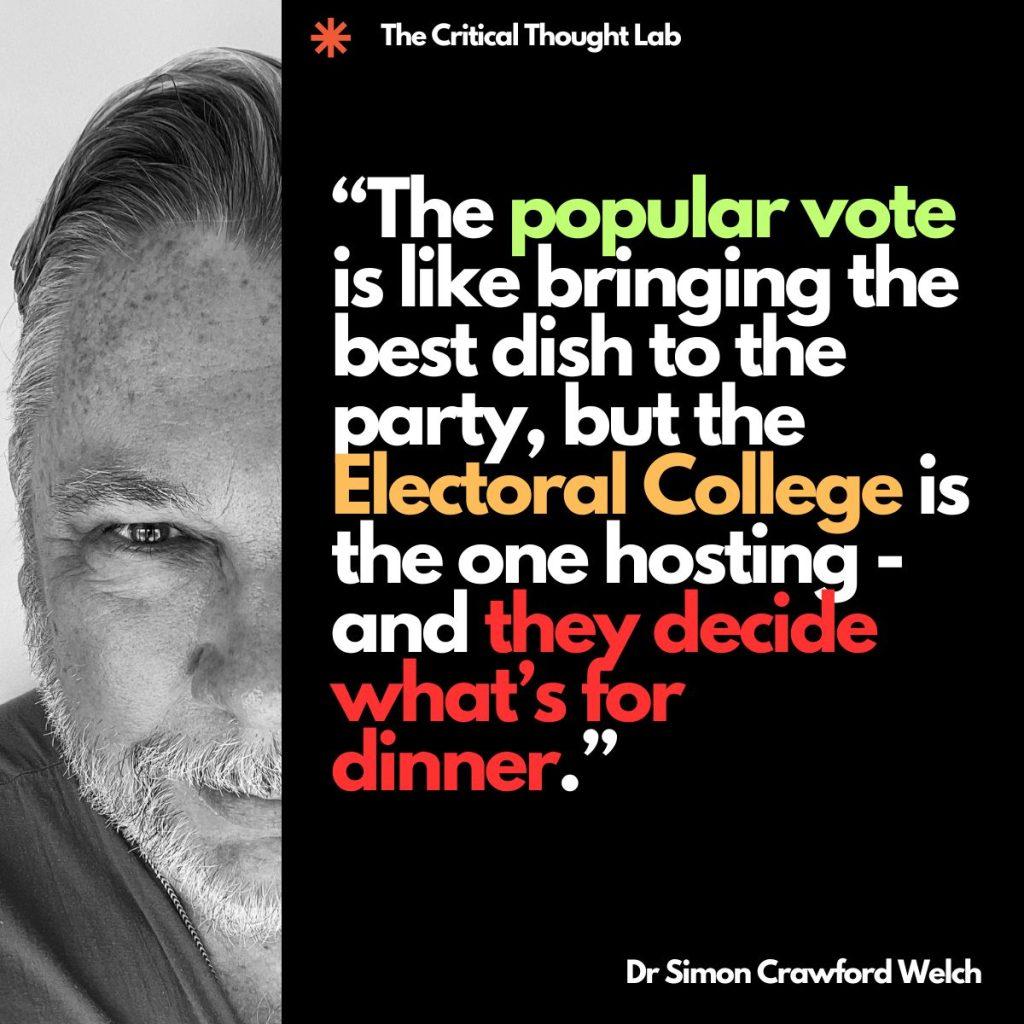By Dr. Simon Crawford-Welch
Founder, The Critical Thought Lab
Follow me at www.linkedin.com/in/simoncrawfordwelch

Before we dive into statistical mechanics, let’s clarify the difference between the popular vote and the Electoral College.
The popular vote is straightforward – it’s the total number of votes cast by individuals across the country. Whoever receives the majority of the popular vote would theoretically win the election if the U.S. election were decided by direct democracy.
The Electoral College, however, is the system enshrined in the Constitution to officially determine the presidency. Each state is allocated a certain number of electors, based on the number of representatives it has in Congress (which is a sum of its Senators and Representatives). This means that smaller states, in terms of population, are often overrepresented compared to larger states, due to the fixed number of Senators each state has (two per state, regardless of population).
When Americans vote in presidential elections, they aren’t directly voting for the president – they’re voting for a slate of electors who then cast their votes in the Electoral College. In all but two states (Maine and Nebraska), these electors cast their votes based on a winner-takes-all system: if a candidate wins the majority of the popular vote in that state, they win all of that state’s electoral votes.
A total of 538 electoral votes are up for grabs, and a candidate needs at least 270 electoral votes to win the presidency. Because of this system, it’s possible for a candidate to win the presidency by securing the majority of electoral votes while losing the national popular vote – a scenario that has occurred in five U.S. elections, most recently in 2000 and 2016.
Statistical Models and Election Predictions
Given the complexity of the Electoral College, election analysts and pollsters use statistical models to predict the probability of various outcomes. Some of the most well-known models, such as those used by FiveThirtyEight, The Economist, and PredictIt, aggregate polling data, historical voting patterns, demographic shifts, and other factors to generate probabilities for each candidate’s likelihood of winning both the popular vote and the Electoral College.
The Role of Polls in Statistical Models
Polls are the most visible tools used to gauge voter sentiment. Pollsters collect data by surveying samples of voters and extrapolating those results to the broader population. However, as we’ve seen in recent elections, polls are not always perfectly accurate, which can lead to surprises on election night. There are several reasons for this:
- Sampling Error: Polls rely on samples of the population, and there’s always a margin of error. Even with sophisticated polling methods, small deviations can lead to miscalculations, particularly in closely contested states.
- Response Bias: Some people may be more likely to answer polls than others, and certain demographics may be under- or overrepresented in the polling data.
- Late-Stage Shifts: Voter preferences can shift in the final days or even hours leading up to the election. Polls conducted weeks before the election may not reflect these last-minute changes in sentiment.
In response to these challenges, statisticians aggregate and weigh different polls to minimize the influence of any one flawed survey. In addition, statistical models account for the uncertainty inherent in polling by producing probabilities rather than definitive predictions. For example, a candidate with a 70% chance of winning may still lose 30% of the time – a lesson many learned in 2016, when Hillary Clinton was given a 70-80% chance of winning by several models, only for Donald Trump to win the Electoral College.
The Math Behind Electoral College Predictions
Because of the winner-takes-all system in most states, winning the presidency is not about getting the most votes nationwide – it’s about winning key states with enough electoral votes to tip the balance. This is where battleground states come into play. States like Florida, Pennsylvania, Wisconsin, and Arizona often determine the outcome of the election because of their history of swinging between parties.
Statistical models break down each state’s polling data, historical trends, and demographics to estimate the likelihood of a candidate winning that state’s electoral votes. For example, Nate Silver’s FiveThirtyEight uses simulations that play out the election thousands of times, calculating the percentage of those simulations in which each candidate wins the necessary electoral votes.
One important aspect of these models is that they show how it’s possible for a candidate to lose the popular vote but win the Electoral College. In 2016, Donald Trump lost the popular vote by nearly 3 million votes but won key battleground states like Wisconsin, Michigan, and Pennsylvania by razor-thin margins, giving him the necessary 270 electoral votes. Statistical models had not accounted sufficiently for the strength of Trump’s support in the Midwest, nor for how voter turnout and electoral overrepresentation in small states could affect the outcome.
The Popular Vote vs. Electoral College Debate: Fair or Flawed?
Critics of the Electoral College argue that it distorts the principle of one person, one vote. A candidate can win millions more votes nationwide and still lose the presidency because of the distribution of votes across states. Furthermore, the Electoral College disproportionately elevates the importance of swing states while rendering solidly blue or red states like California and Texas less influential in the outcome.
On the flip side, supporters of the Electoral College argue that it ensures geographical diversity in the presidential selection process. Without it, candidates might focus solely on winning the largest population centers, like New York City, Los Angeles, and Chicago, neglecting rural and smaller states. The Electoral College forces candidates to campaign across a broader spectrum of the country.
Statistical Imbalances: How the Electoral College Skews Representation
The statistical imbalance created by the Electoral College is significant. Consider the state of Wyoming, which has three electoral votes for its population of around 578,000 people. By contrast, California, with a population of nearly 40 million, has 55 electoral votes. This means that a vote in Wyoming has proportionally much more impact on the Electoral College outcome than a vote in California. In practice, this means that voters in smaller, less populous states have more electoral influence than those in larger states – something that is built into the system, but increasingly questioned in modern politics.
The Future of the Electoral College
As the 2024 election approaches, we can expect renewed debates about the Electoral College’s fairness. Several states have already signed onto the National Popular Vote Interstate Compact, an agreement that would ensure the presidency goes to the winner of the national popular vote – once enough states join to constitute an electoral majority (270 electoral votes). While this compact is gaining traction, it still faces legal and political challenges.
At the same time, statistical models will continue to shape our understanding of electoral probabilities. Voters, the media, and candidates alike will rely on these models to gauge their chances. But it’s important to remember that probabilities are not predictions. Just because a model says a candidate has a 70% chance of winning doesn’t mean the outcome is certain. The Electoral College, voter turnout, and polling errors can – and often do – produce surprises.
Navigating the Uncertainty
The 2024 election, like those before it, will be shaped by a combination of voter preferences, statistical probabilities, and the unique mechanics of the Electoral College. While polls and statistical models offer valuable insights, they come with inherent uncertainties. Understanding how these systems work can help voters approach election results with a more nuanced perspective.
Ultimately, the tension between the popular vote and the Electoral College will remain a central issue in American democracy. Whether future reforms reshape the way presidents are elected or whether the current system persists, voters and analysts alike must learn to interpret election data through a lens of probability, not certainty. As the election season unfolds, we’ll see once again how this intricate balance between statistics and democracy plays out on the national stage.



